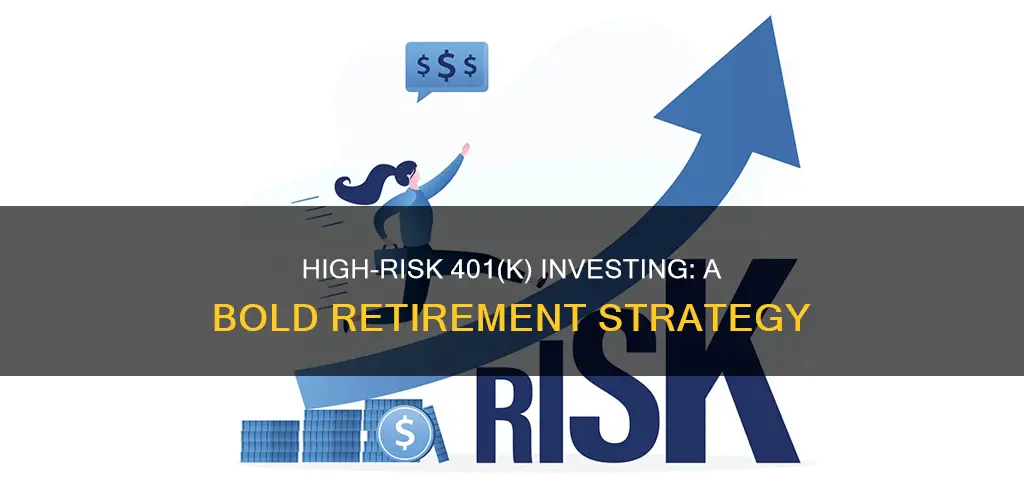
When investing in a 401(k), it's important to consider your risk tolerance. Everyone has a different risk appetite, and the level of risk you're willing to take on will depend on your financial goals and personality. If you have a high-risk tolerance, you may be comfortable with a more aggressive investment strategy, such as investing in stocks. However, it's important to remember that higher risk can also mean higher returns, but also higher losses. On the other hand, lower-risk investment types can help maintain the value of your 401(k) and provide more stability, but they typically come with lower returns.
| Characteristics | Values |
|---|---|
| Risk tolerance | High-risk investments may be suitable for those with a high investing risk tolerance, who are comfortable with the possibility of dramatic losses in exchange for the potential for big gains |
| Diversification | A diversified stock portfolio can reduce risk, but less diversification may mean higher risk |
| Market cycles | A 401(k) will be affected by market cycles, but some investment choices can provide more stability |
| Risk and return | Lower-risk investments typically result in lower returns, while higher-risk investments offer the potential for greater gains but also come with the possibility of more significant losses |
| Investment options | Bond funds, money market funds, index funds, stable value funds, and target-date funds are lower-risk options for a 401(k) |
What You'll Learn

Risk tolerance
If you have a high-risk tolerance, you may be comfortable weighting your portfolio with lesser-proven stocks or other investments that could be on the cusp of big gains but could also dip dramatically if certain assumptions about markets and demand don't materialise. However, it's worth noting that less diversification may mean higher risk. If your portfolio is all stocks, for example, it may not be as diversified as it could be, and you could be vulnerable to negative impacts on the stock market as a whole.
On the other hand, if you prefer to play it safe, there are a number of lower-risk investment options for your 401(k). These include bond funds, money market funds, index funds, stable value funds, and target-date funds. Each investment type has its own risk profile, and it's important to consider that lower risk usually means lower returns. Target-date funds, for example, are set up to automatically decrease the percentage of higher-risk investments as savers get closer to retirement, sacrificing potential growth for increased confidence in the long-term value of their portfolio.
Ultimately, the level of risk you're comfortable with will depend on your personal financial goals and risk tolerance. It's important to remember that a 401(k) is a tool designed to support your retirement goals, and you should choose investments that align with your risk tolerance and objectives.
Staffing Agency Investment Strategies: Where to Focus Your Money
You may want to see also

Diversification
When investing in a 401(k)>, it's important to understand your risk tolerance. A 401(k) is a tool designed to support your retirement goals, and you should choose investment options that align with your risk appetite.
For example, if your portfolio consists solely of stocks, it may not be adequately diversified. If something negatively impacts the stock market as a whole, your portfolio value could take a significant hit. On the other hand, if you diversify your portfolio to include other asset classes, such as bonds or cash, you can reduce the overall risk.
Bonds, in particular, can be a useful addition to a diversified portfolio. Bond funds, including government bonds, are typically considered lower-risk investments than stocks. They can provide stability to your portfolio, especially as you approach retirement age. Money market funds, index funds, and stable value funds are also lower-risk options that can help maintain the value of your 401(k).
It's important to note that lower risk generally means lower returns. While diversification can help reduce the impact of losses, it may also result in sacrificing potential growth. Therefore, it's crucial to assess your investing risk threshold and choose a diversification strategy that aligns with your financial goals and risk tolerance.
A Guide to Investing in Vanguard's S&P 500 from India
You may want to see also

Market cycles
Those with a high-risk tolerance may be comfortable with a more aggressive investment strategy. This could involve weighting their portfolio with lesser-proven stocks or other high-risk, high-reward investments. However, it's important to remember that while these investments have the potential for significant gains, they also carry the risk of dramatic losses.
On the other hand, individuals with a lower risk tolerance may prefer to invest in more stable options. Lower-risk investment types, such as bond funds, money market funds, index funds, stable value funds, and target-date funds, can help maintain the value of your 401(k). While these options typically offer lower returns, they provide a more conservative approach that may be better suited for those seeking long-term stability.
Additionally, diversification plays a crucial role in managing risk. A diversified stock portfolio can help protect against market downturns. By spreading your investments across different asset classes, you reduce the impact of any single negative event. However, it's important to note that diversification may not always shield you from market-wide events that affect all stocks simultaneously.
As you approach retirement, it's common to adjust your investment strategy. Many professionally managed model portfolios and target-date funds are designed to automatically decrease the percentage of higher-risk investments as savers get closer to retirement. This shift towards stability helps ensure that your portfolio can cover living costs during retirement, even if it means sacrificing potential growth. Ultimately, the key to successful investing in a 401(k) is understanding your risk tolerance and making informed decisions that align with your retirement goals.
Smart Strategies to Turn $5000 into $1 Million
You may want to see also

Lower-risk investment types
When investing in a 401(k)>, it's important to consider your risk tolerance. While higher-risk investments can lead to greater potential gains, they also come with the possibility of more significant losses. If you have a lower risk tolerance, there are several investment options available that can help maintain the stability of your portfolio.
One option is to invest in bond funds. Bond funds are a type of pooled investment vehicle for debt securities, and they typically focus on a particular type of bond, such as government bonds. While risk levels can vary depending on the specific bond fund, they are generally considered less risky than stock mutual funds.
Money market funds are another lower-risk investment choice. Money market funds invest in short-term debt instruments, such as treasury bills, certificates of deposit (CDs), and commercial paper. These types of investments are considered relatively safe and liquid, providing stability to your portfolio.
Index funds are also worth considering for lower-risk investors. Index funds aim to replicate the performance of a specific stock market index, such as the S&P 500. By investing in a diversified portfolio of stocks that mirror the index, index funds offer a more stable investment strategy compared to picking individual stocks.
Additionally, stable value funds can provide a conservative investment option for those seeking lower risk. Stable value funds typically invest in high-quality, fixed-income securities, such as government and corporate bonds, and are designed to preserve capital and provide steady returns.
Finally, target-date funds are a common choice for investors seeking to reduce risk as they approach retirement. These funds are designed to automatically adjust their asset allocation over time, becoming more conservative as the target retirement date approaches. This helps strike a balance between growth and stability, ensuring that your portfolio aligns with your changing risk tolerance over time.
Maximizing CD Investments: Strategies for Higher Returns
You may want to see also

Risk and returns
When investing in a 401(k)>, it's important to consider your risk tolerance and the potential returns. Everyone has a different risk appetite, and it's crucial to assess your investing risk threshold. The more risk you take on, the greater the potential gains, but also the greater the potential losses. If you have a high-risk tolerance, you may be comfortable weighting your portfolio with lesser-proven stocks or other investments that could be on the cusp of big gains but could also dip dramatically if certain assumptions about markets and demand don't materialise.
Lower-risk investment types can help maintain the value of your 401(k), but it's important to remember that lower risk usually means lower returns. Bond funds, money market funds, index funds, stable value funds, and target-date funds are lower-risk options for your 401(k). Each investment type has its own risk profile, and it's important to consider the level of risk you're comfortable with.
One strategy for managing risk in a 401(k) is to diversify your portfolio. A diversified stock portfolio can help protect against specific risks that impact certain stocks. However, if your portfolio is all stocks, it may not be as diversified as it could be. Including some cash-producing bonds or CDs can help weather downturns and allow you to stay invested in stocks, which typically show better long-term returns.
As you get closer to retirement, it's common to decrease the percentage of higher-risk investments in your 401(k). This is because you're more likely to start taking distributions from your retirement funds to cover living costs. During this time, stability in your portfolio may become a higher priority than potential growth. It's important to remember that a 401(k) is a tool designed to support your retirement goals, and choosing the right investment mix depends on your individual risk tolerance and financial goals.
Strategic Equity Investment: A Comprehensive Guide
You may want to see also
Frequently asked questions
Lower-risk investment types can help maintain the value of your 401(k). These include bond funds, money market funds, index funds, stable value funds, and target-date funds.
If your portfolio is all stocks, then you might not generate much cash. It can be useful to have a portfolio with some cash-producing bonds or CDs, helping you weather a downturn or allowing you to stay invested in stocks, which usually show better long-term returns.
The overarching principle about risk is that the more you assume, the greater your potential gains but also the greater your potential losses. If you have a high investing risk tolerance, you may be OK with weighting your portfolio with lesser-proven stocks or other investments that could be on the cusp of big gains but could also dip dramatically.
Less diversification may mean higher risk. If your portfolio is all stock, then you are not as diversified as you could be. If something negatively impacts stocks as a whole, your diversification among stocks won't help you.
Many professionally managed model portfolios and target date funds are set up to automatically decrease the percentage of higher-risk investments as savers get closer to retirement. This is a common strategy for retirement savings portfolios.







